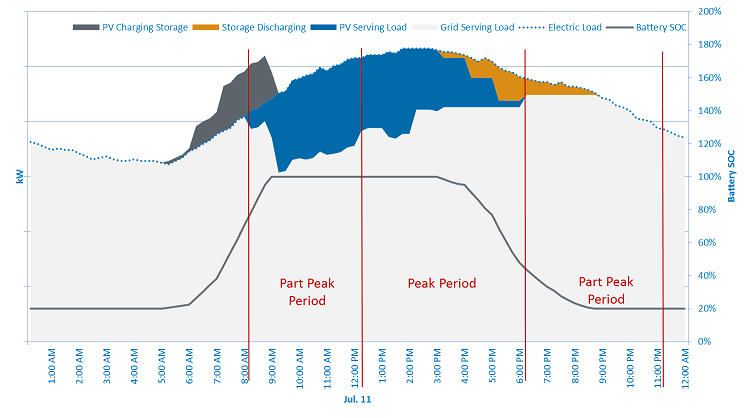REopt Evaluates the Economic Potential of PV Plus Battery Storage at a Military Base in California

PV and battery reduce peak demand at a military base. Illustration from Emma Elgqvist, NREL
NREL used the REopt® model to evaluate the economic potential of PV paired with battery storage at a base in California. Using the site’s 15-minute interval data and utility tariff (SCE TOU-8), NREL determined the optimal size of solar photovoltaics (PV) and battery, and the optimal battery dispatch, to minimize the life cycle cost of electricity for the site. NREL found that at this site PV alone was cost-effective, but when paired with a battery, a larger PV system could be installed with greater life cycle cost savings.
While PV generates according to when the resource is available, a site must decide when to operate a storage system. REopt’s economic optimization model allows NREL to identify the size of storage and associated dispatch strategy that maximizes the economic benefit of the integrated system. As shown in the image above, the site’s demand charges are different throughout the day, and the peak is shaved to different levels in each demand period. NREL doesn’t set demand targets; rather, these levels are determined by the optimization model. The peak demand period is too long for the battery on its own, but by using PV to shave much of it, and adding in battery on the shoulders, together these technologies are very effective in reducing demand.
Related Stories
NREL presentation: Energy Storage Versus Back-up Generation: Energy Storage Overview
NREL fact sheet: REopt Lite Web Tool Evaluates Photovoltaics and Battery Storage
NREL presentation: Energy Storage Economics
NREL poster: Optimizing Energy Storage Economics
NREL conference paper: A Statistical Analysis of the Economic Drivers of Battery Energy Storage in Commercial Buildings
NREL conference paper: Optimal Sizing of a Solar-Plus-Storage System for Utility Bill Savings and Resiliency Benefits
Sponsors
Department of Defense
Contact
Share
Last Updated Feb. 11, 2025
